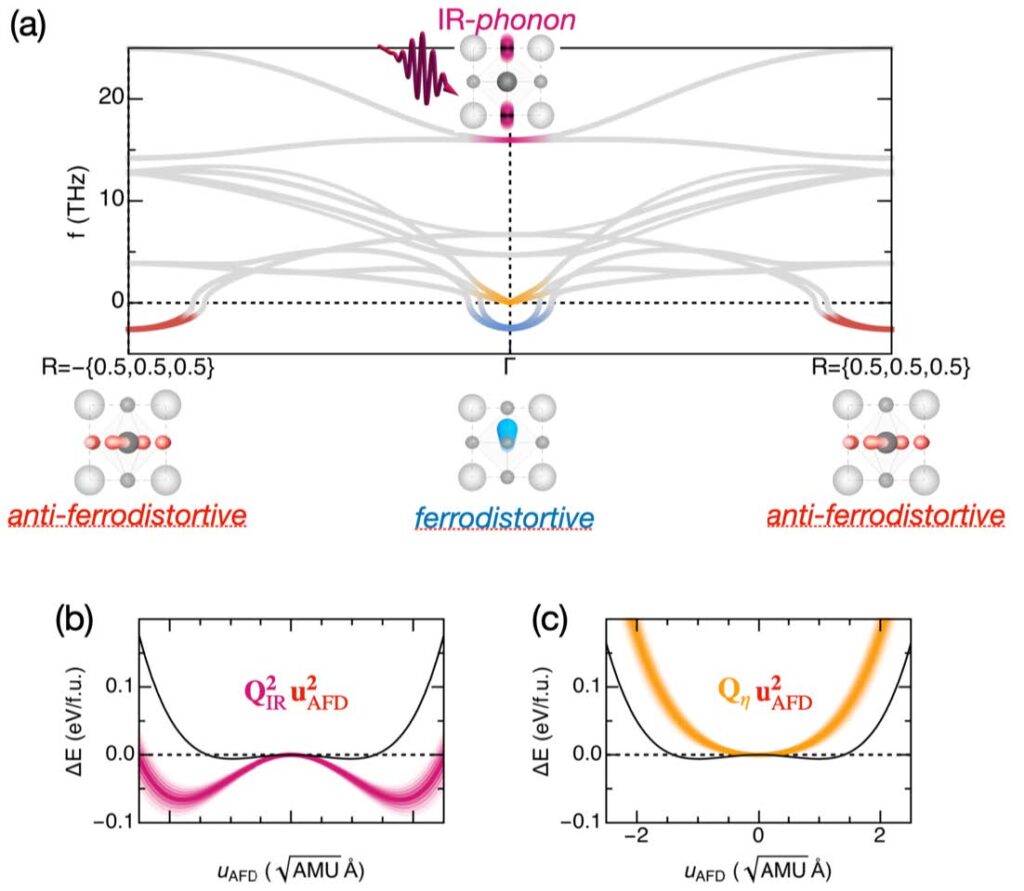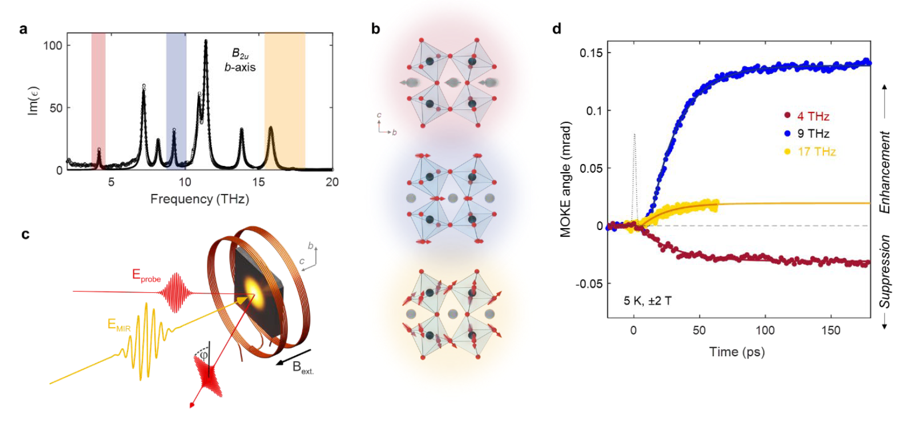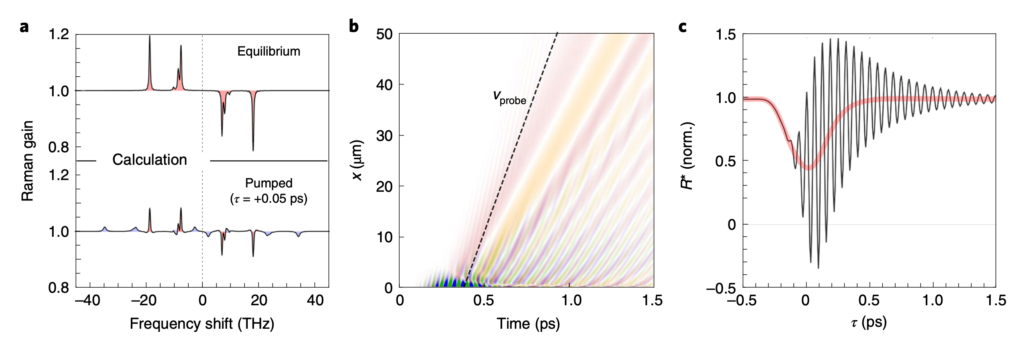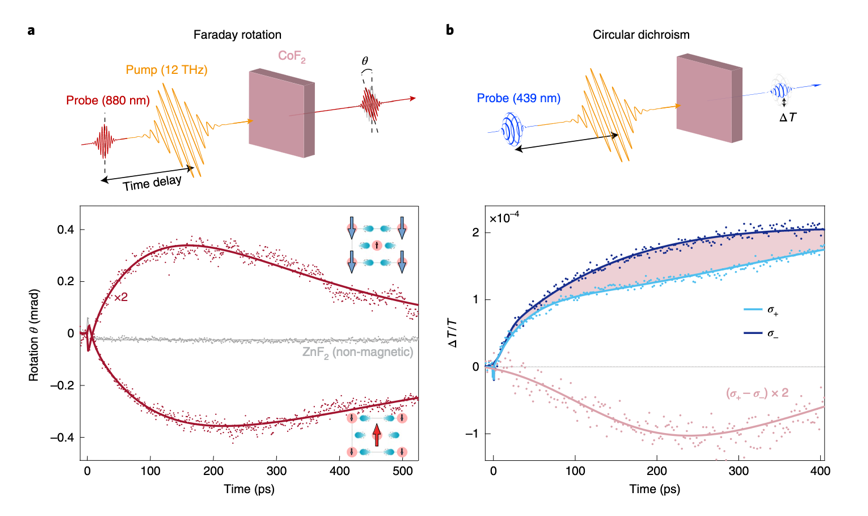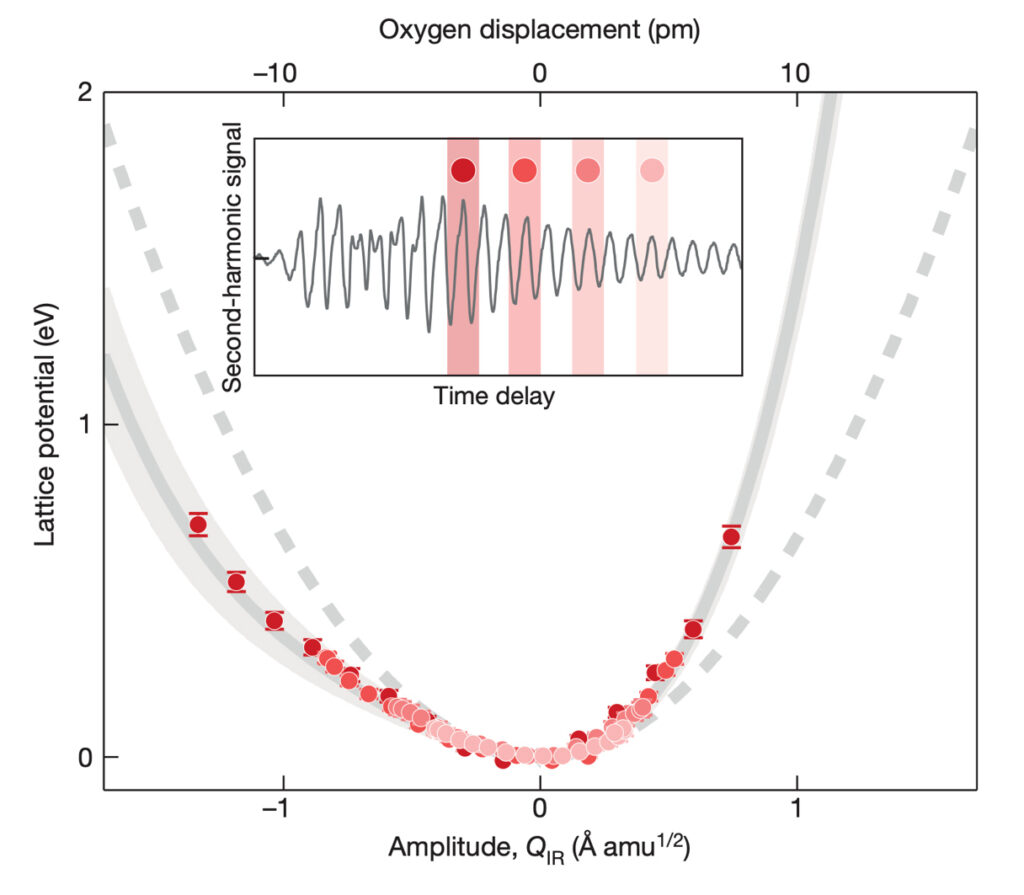Density Functional Theory (DFT) is a powerful computational method used extensively in physics, chemistry, and materials science to study the electronic and nuclear structure of many-body systems, including atoms, molecules, and condensed phases. By using functionals, which are functions of another function, DFT can determine the properties of a many-electron system based on the electron density. In addition to its primary use as a ground-state method, DFT is also a valuable tool for exploring non-equilibrium physics. For example, it can compute phonon excitation spectra and nonlinear couplings, such as phonon-phonon interactions. The latter becomes essential for guiding and predicting experiments utilizing nonlinear phononics. In addition, DFT can accurately calculate optical response functions and their derivatives with respect to perturbations, making it an important tool for analyzing nonlinear spectroscopy results.
Relevant publications
Quenched lattice fluctuations in optically driven SrTiO3
M. Fechner, M. Först, G. Orenstein, V. Krapivin, A. Disa, M. Buzzi, A. von Hoegen, G. de la Pena, Q. L. Nguyen, R. Mankowsky, M. Sander, H. Lemke, Y. Deng, M. Trigo, A. Cavalleri
arXiv:2301.08703
Abstract
Many functionally relevant ferroic phenomena in quantum materials can be manipulated by driving the lattice coherently with optical and terahertz pulses. New physical phenomena and non-equilibrium phases that have no equilibrium counterpart have been discovered following these protocols. The underlying structural dynamics has been mostly studied by recording the average atomic position along dynamical structural coordinates with elastic scattering methods. However, crystal lattice fluctuations, which are known to influence phase transitions in equilibrium, are also expected to determine these dynamics but have rarely been explored. Here, we study the driven dynamics of the quantum paraelectric SrTiO3, in which mid-infrared drives have been shown to induce a metastable ferroelectric state9. Crucial in these physics is the competition between the polar instability and antiferrodistortive rotations, which in equilibrium frustrate the formation of long-range ferroelectricity. We make use of high intensity mid-infrared optical pulses to resonantly drive a Ti-O stretching mode at 17 THz, and we measure the resulting change in lattice fluctuations using time-resolved x-ray diffuse scattering at a free electron laser. After a prompt increase, we observe a long-lived quench in R-point antiferrodistortive lattice fluctuations. The enhancement and reduction in lattice fluctuations are explained theoretically by considering fourth-order nonlinear phononic interactions and third-order coupling to the driven optical phonon and to lattice strain, respectively. These observations provide a number of new and testable hypotheses for the physics of light-induced ferroelectricity.
Photo-induced high-temperature ferromagnetism in YTiO3
A. S. Disa, J. Curtis, M. Fechner, A. Liu, A. von Hoegen, M. Först, T. F. Nova, P. Narang, A. Maljuk, A. V. Boris, B. Keimer & A. Cavalleri
Nature, 617, 73–78 (2023)
Abstract
In quantum materials, degeneracies and frustrated interactions can In quantum materials, degeneracies and frustrated interactions can have a profound impact on the emergence of long-range order, often driving strong fluctuations that suppress functionally relevant electronic or magnetic phases. Engineering the atomic structure in the bulk or at heterointerfaces has been an important research strategy to lift these degeneracies, but these equilibrium methods are limited by thermodynamic, elastic and chemical constraints. Here we show that all-optical, mode-selective manipulation of the crystal lattice can be used to enhance and stabilize high-temperature ferromagnetism in YTiO3, a material that shows only partial orbital polarization, an unsaturated low-temperature magnetic moment and a suppressed Curie temperature, Tc = 27 K. The enhancement is largest when exciting a 9 THz oxygen rotation mode, for which complete magnetic saturation is achieved at low temperatures and transient ferromagnetism is realized up to Tneq > 80 K, nearly three times the thermodynamic transition temperature. We interpret these effects as a consequence of the light-induced dynamical changes to the quasi-degenerate Ti t2g orbitals, which affect the magnetic phase competition and fluctuations found in the equilibrium state. Notably, the light-induced high-temperature ferromagnetism discovered in our work is metastable over many nanoseconds, underscoring the ability to dynamically engineer practically useful non-equilibrium functionalities.
Nonlocal nonlinear phononics
M. Henstridge, M. Först, E. Rowe, M. Fechner, A. Cavalleri
Nature Physics, 18, 457–461 (2022)
Abstract
Nonlinear phononics relies on the resonant optical excitation of infrared-active lattice vibrations to induce targeted structural deformations in solids. This form of dynamical crystal structure design has been applied to control the functional properties of many complex solids, including magnetic materials, superconductors and ferroelectrics. However, phononics has so far been restricted to protocols in which structural deformations occur within the optically excited volume, sometimes resulting in unwanted heating. Here, we extend nonlinear phononics to propagating polaritons, spatially separating the functional response from the optical drive. We use mid-infrared optical pulses to resonantly drive a phonon at the surface of ferroelectric LiNbO3. Time-resolved stimulated Raman scattering reveals that the ferroelectric polarization is reduced over the entire 50 μm depth of the sample, far beyond the micrometre depth of the evanescent phonon field. We attribute this effect to the anharmonic coupling between the driven mode and a polariton that propagates in o the material. For high excitation amplitudes, we reach a regime in which the ferroelectric polarization is reversed, as revealed by a sign change in the Raman tensor coefficients of all the polar modes.
Polarizing an antiferromagnet by optical engineering of the crystal field
A. S. Disa, M. Fechner, T. F. Nova, B. Liu, M. Först, D. Prabhakaran, P. G. Radaelli, A. Cavalleri
Nature Physics 16, 937–941 (2020)
Abstract
Strain engineering is widely used to manipulate the electronic and magnetic properties of complex materials. For example, the piezomagnetic effect provides an attractive route to control magnetism with strain. In this effect, the staggered spin structure of an antiferromagnet is decompensated by breaking the crystal field symmetry, which induces a ferrimagnetic polarization. Piezomagnetism is especially appealing because, unlike magnetostriction, it couples strain and magnetization at linear order, and allows for bi-directional control suitable for memory and spintronics applications. However, its use in functional devices has so far been hindered by the slow speed and large uniaxial strains required. Here we show that the essential features of piezomagnetism can be reproduced with optical phonons alone, which can be driven by light to large amplitudes without changing the volume and hence beyond the elastic limits of the material. We exploit nonlinear, three-phonon mixing to induce the desired crystal field distortions in the antiferromagnet CoF2. Through this effect, we generate a ferrimagnetic moment of 0.2 μB per unit cell, nearly three orders of magnitude larger than achieved with mechanical strain.
Probing the Interatomic Potential of Solids with Strong-Field Nonlinear Phononics
A. von Hoegen, R. Mankowsky, M. Fechner, M. Först, A. Cavalleri
Nature, 555, 79–82 (2018)
Abstract
Nonlinear optical techniques at visible frequencies have long been applied to condensed matter spectroscopy. However, because many important excitations of solids are found at low energies, much can be gained from the extension of nonlinear optics to mid-infrared and terahertz frequencies. For example, the nonlinear excitation of lattice vibrations has enabled the dynamic control of material functions. So far it has only been possible to exploit secondorder phonon nonlinearities9 at terahertz field strengths near one million volts per centimetre. Here we achieve an order-of-magnitude increase in field strength and explore higher-order phonon nonlinearities. We excite up to five harmonics of the A1 (transverse optical) phonon mode in the ferroelectric material lithium niobate. By using ultrashort mid-infrared laser pulses to drive the atoms far from their equilibrium positions, and measuring the largeamplitude atomic trajectories, we can sample the interatomic potential of lithium niobate, providing a benchmark for ab initio calculations for the material. Tomography of the energy surface by high-order nonlinear phononics could benefit many aspects of materials research, including the study of classical and quantum phase transitions.


